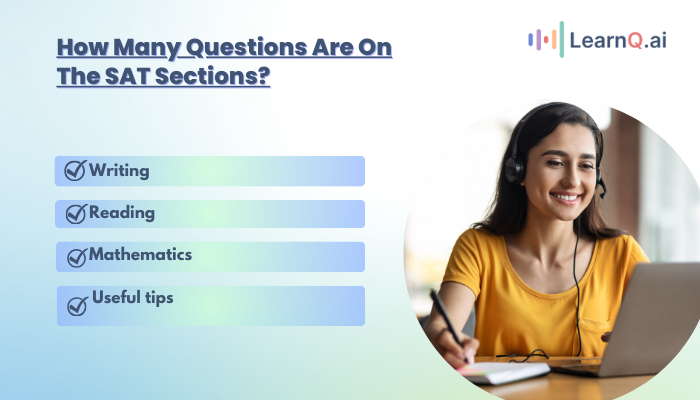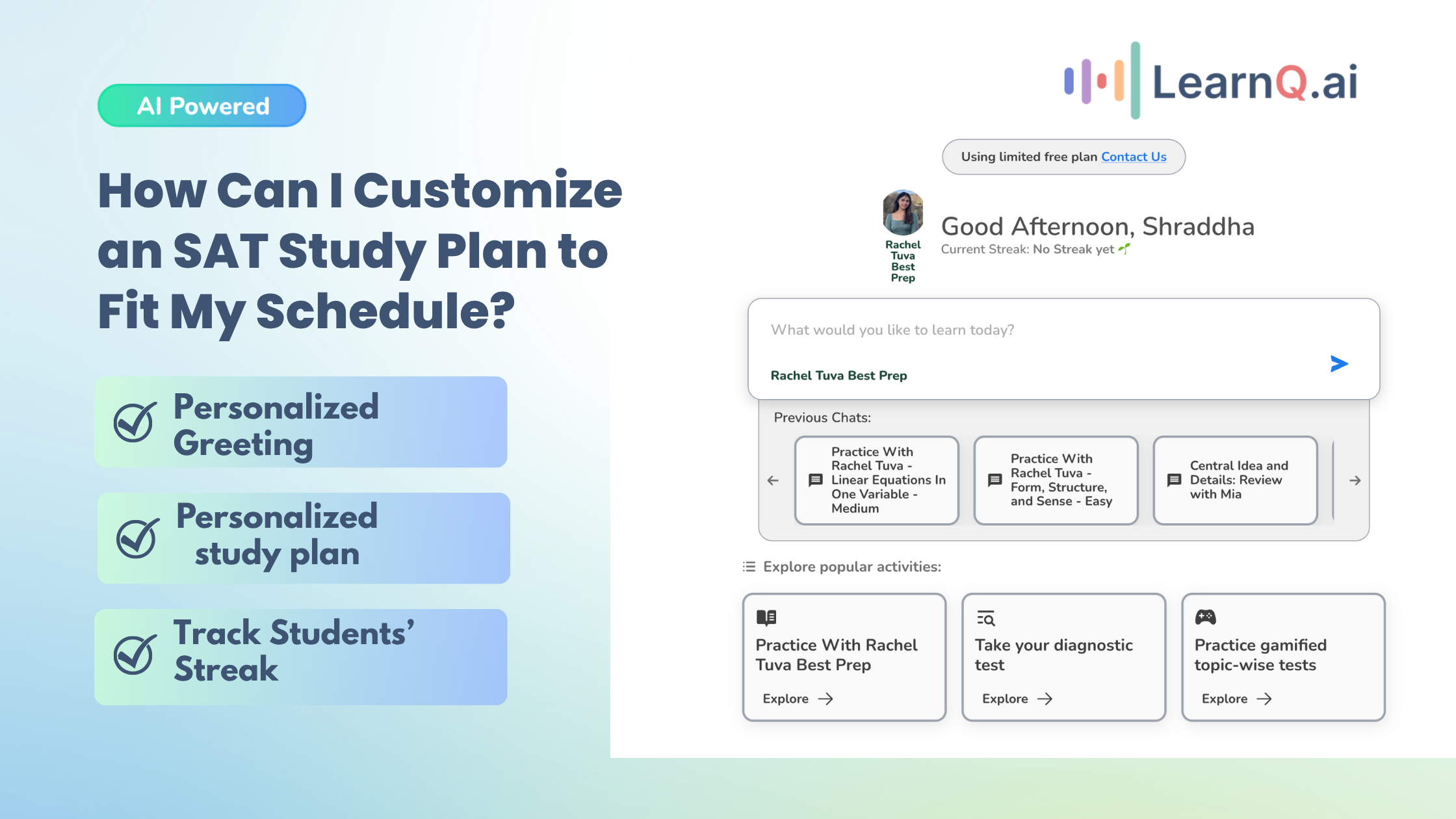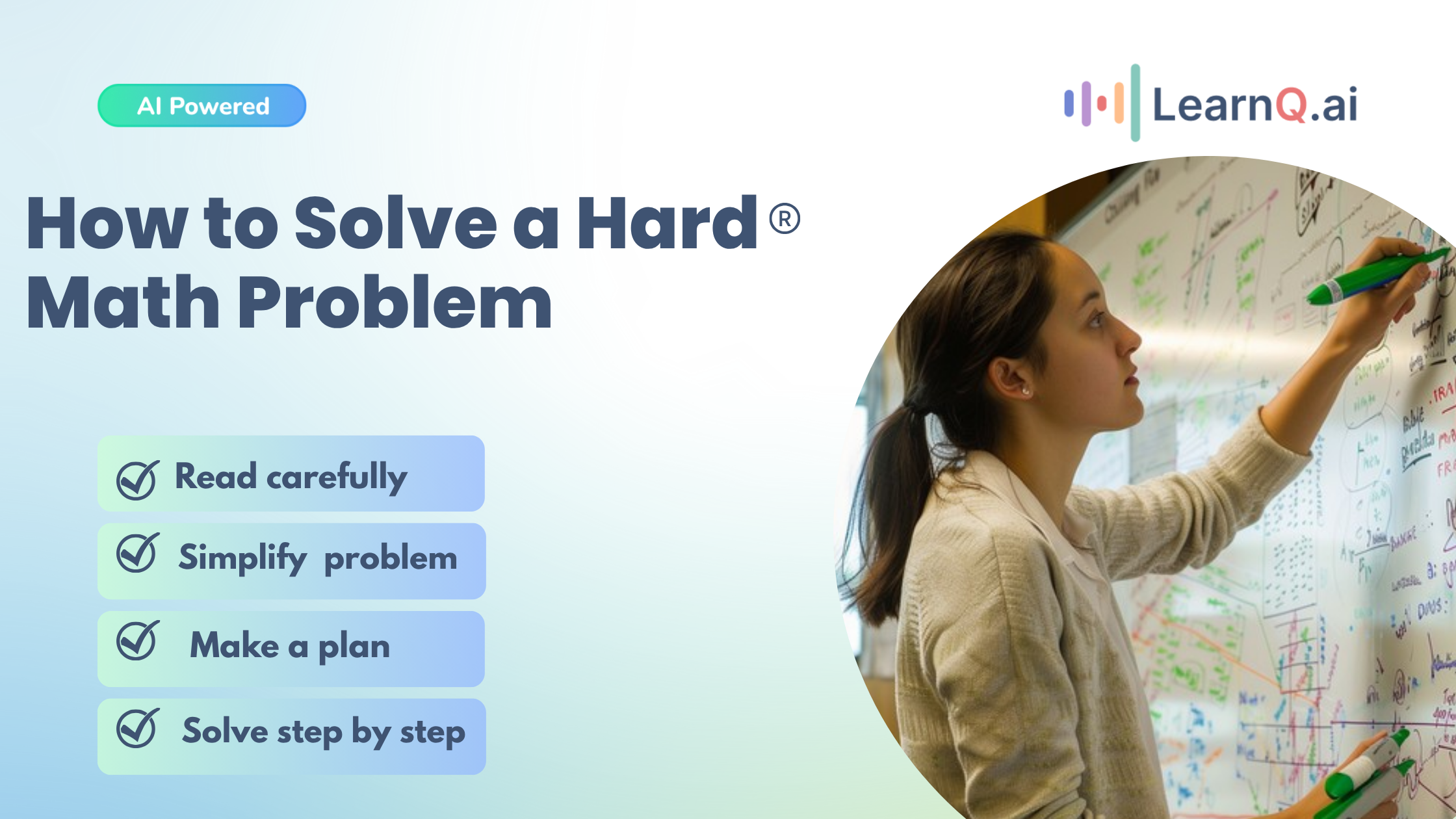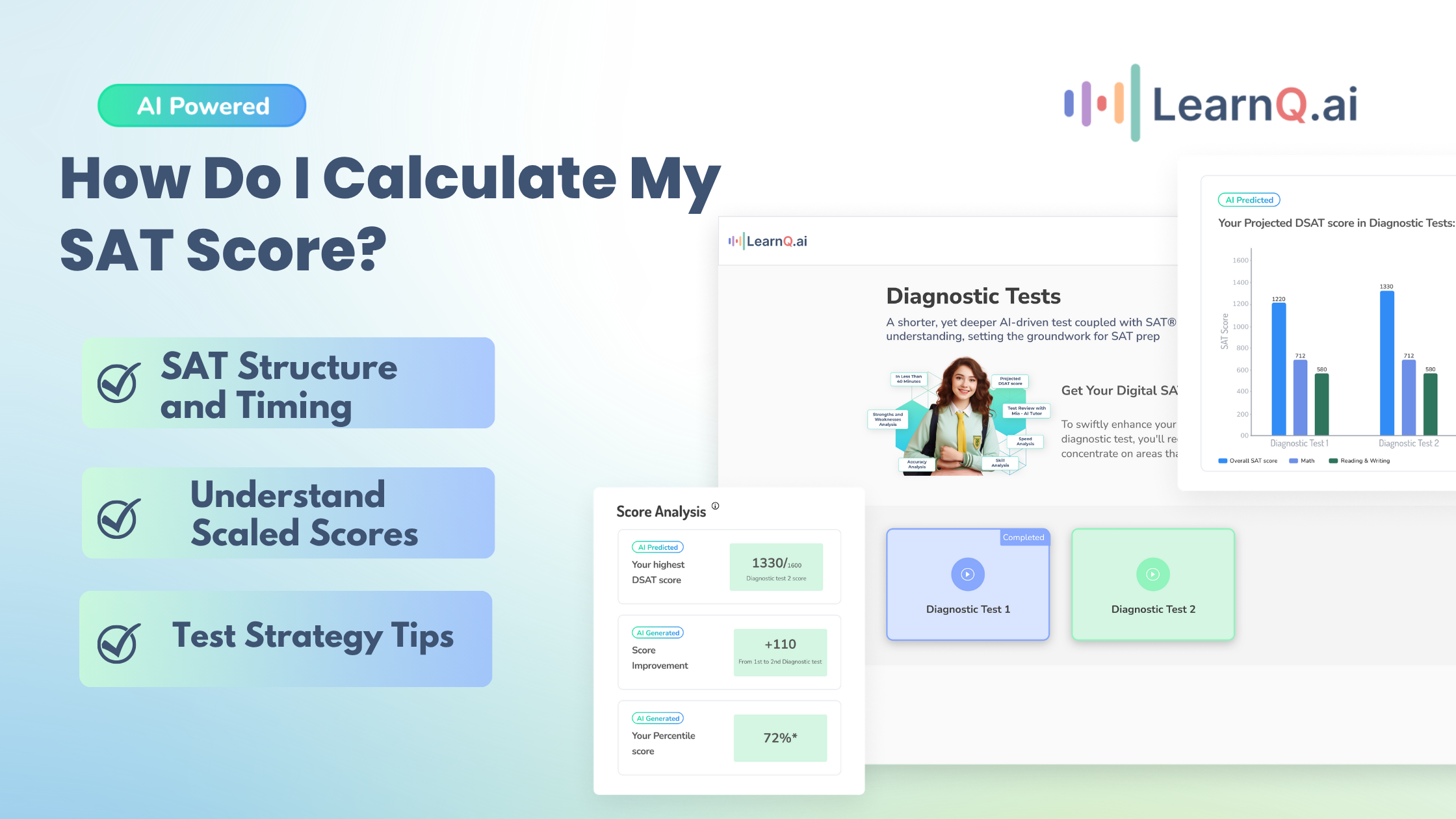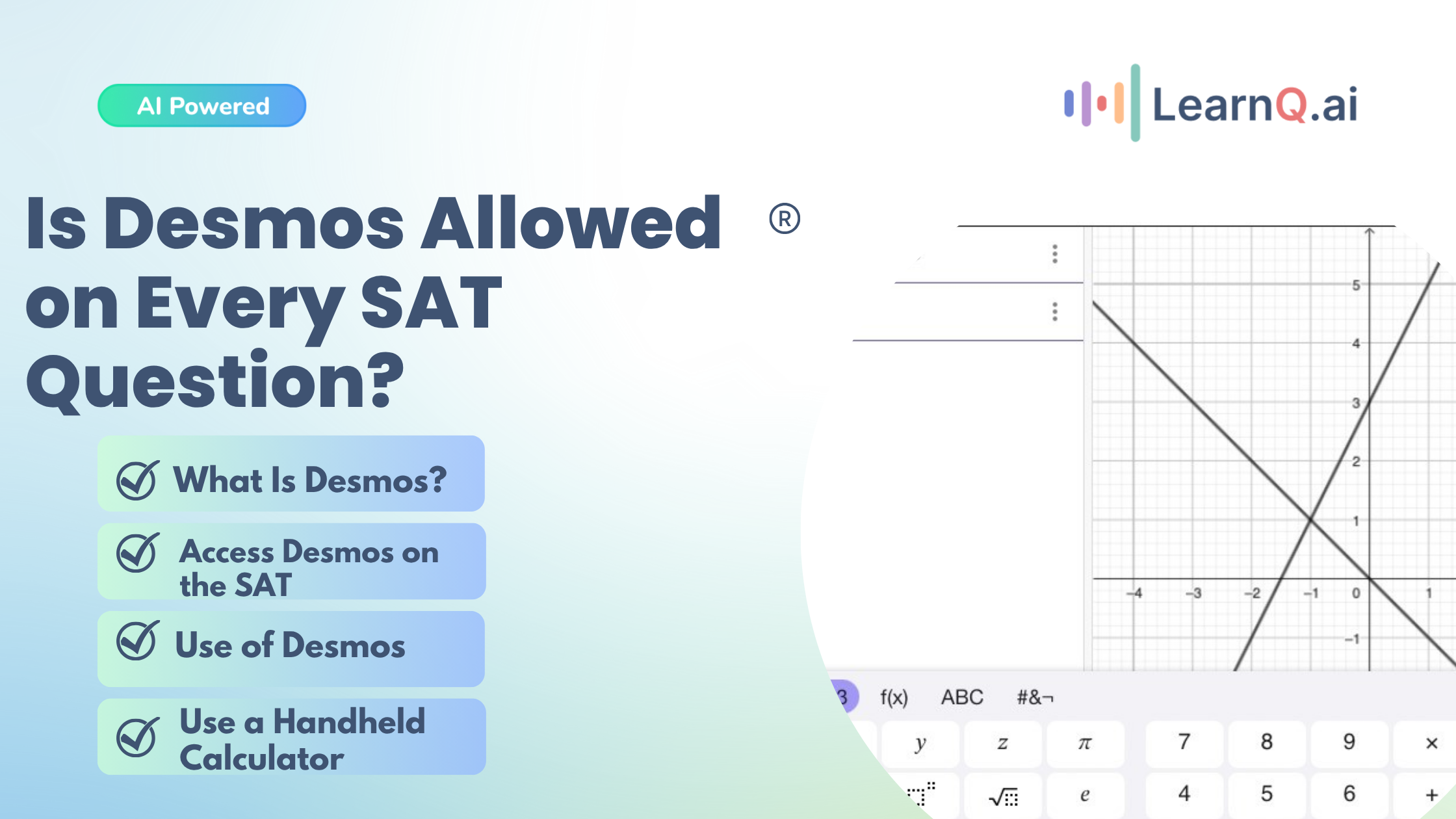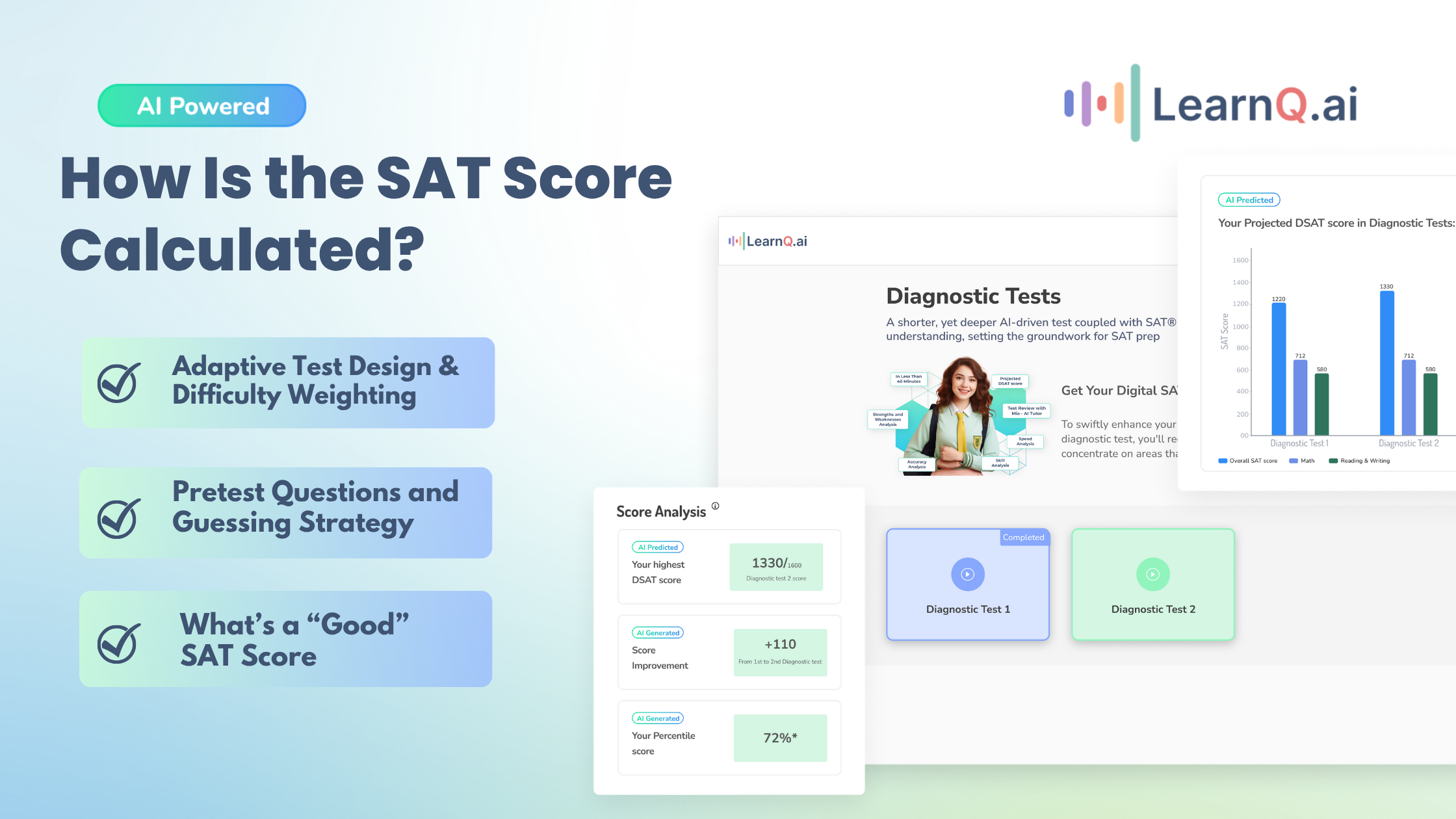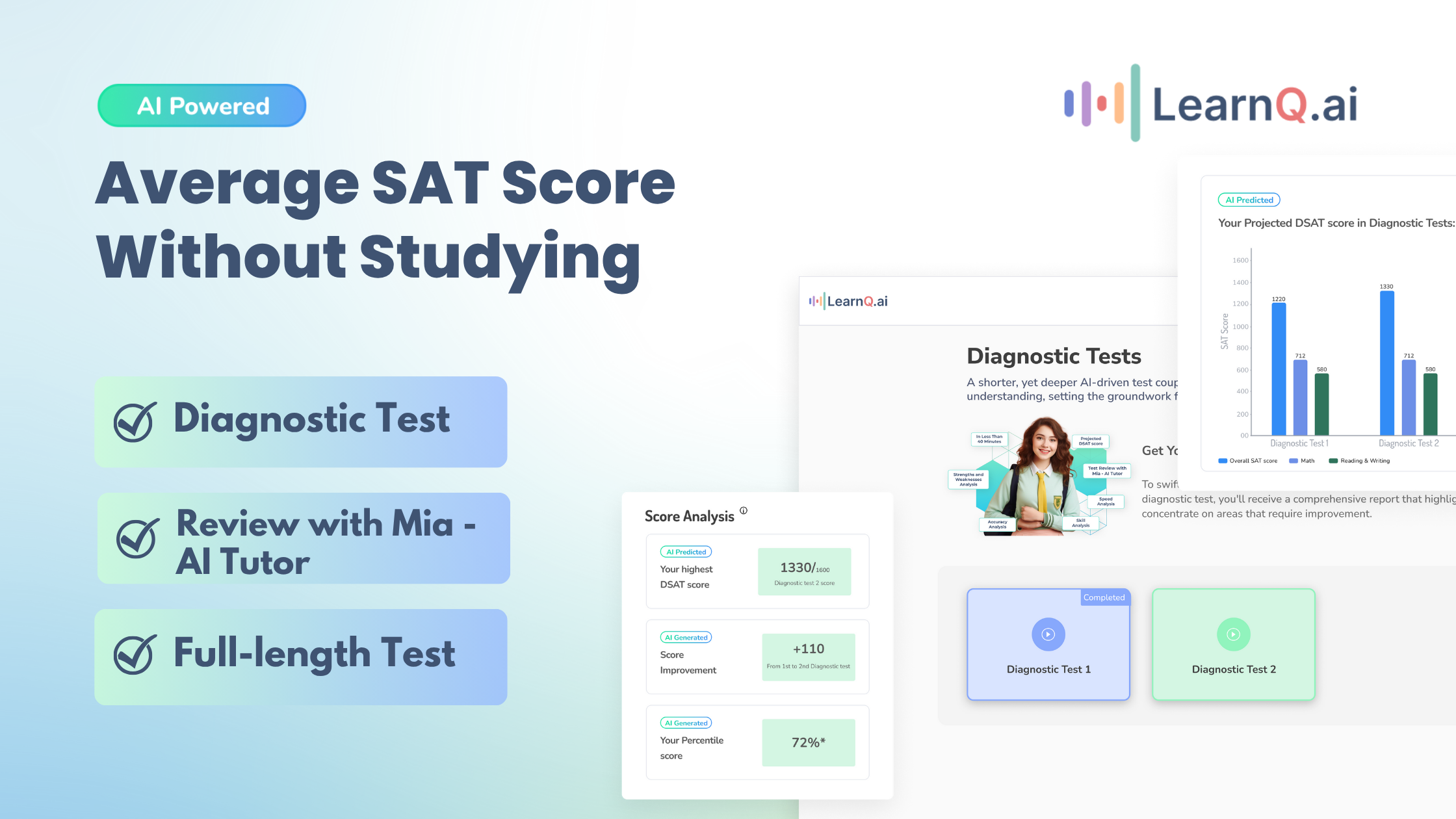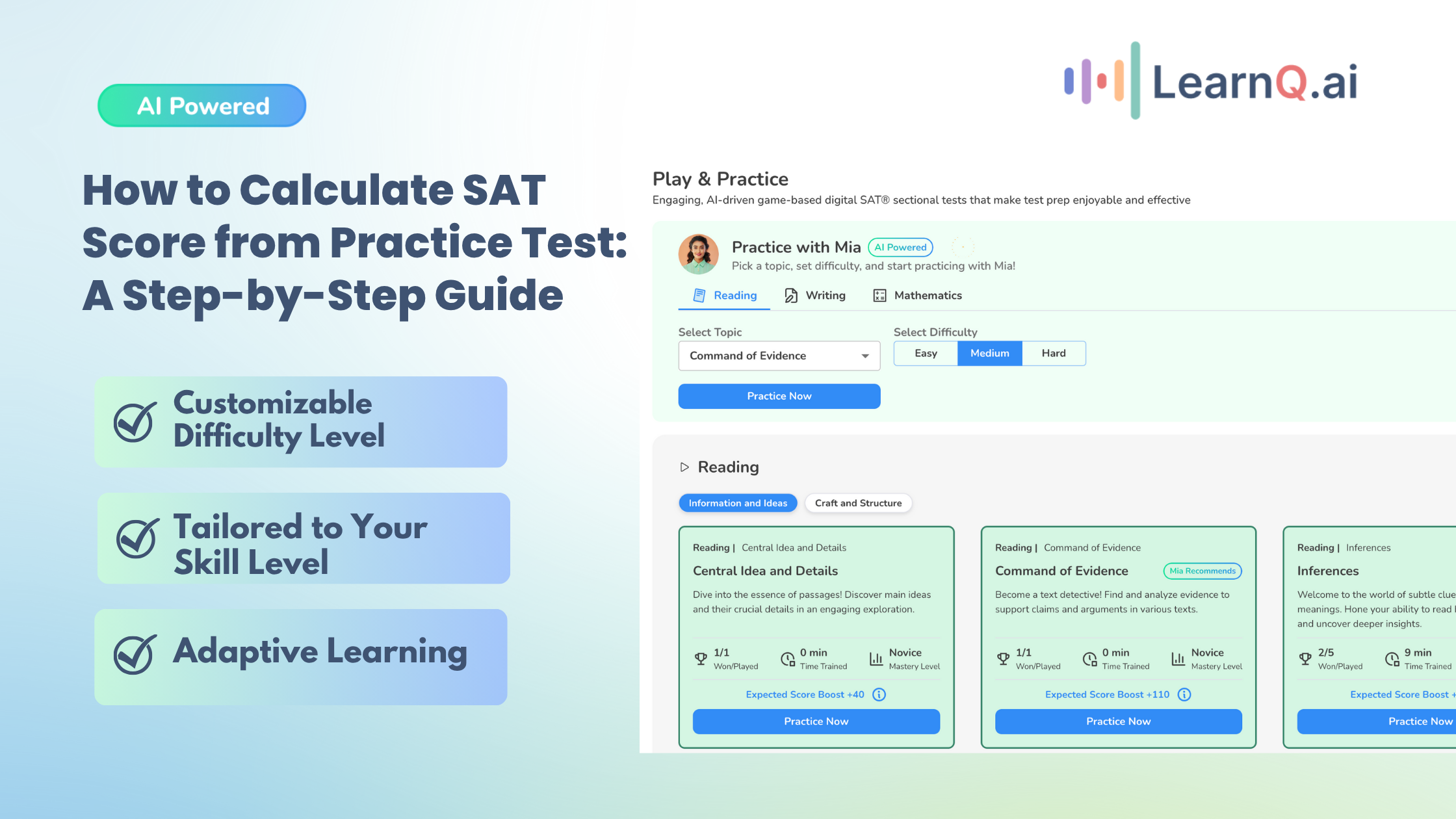The SAT marks a crucial step in your academic journey. Acing this test can unlock doors to top universities and scholarships, propelling you towards your dream academic path. But approaching the SAT with confidence requires understanding its format and the specific skills it assesses.
Knowing the test’s structure – Math, Reading & Writing – the question types, and time limits per section empowers you to build effective test-taking strategies and manage your time efficiently during the exam. This knowledge is key to tackling each section with confidence and maximizing your performance on test day.
LearnQ.ai is Powered by VEGA AI—Is your Institute Next?
Give students a Duolingo-style test-prep platform with Shopify-level customization for tutors and institutes.
Overview of SAT Sections
The digital SAT is composed of two sections: Reading and Writing and Math. You will have 64 minutes to complete the Reading and Writing section and 70 minutes to complete the Math section making a total of 2 hours and 14 minutes.
Each section is divided into two equal-length modules, with a 10-minute break between the Reading and Writing section and the Math section.
- The first module of each section contains a broad mix of easy, medium, and hard questions.
- Based on how you perform on the first module, the second module of questions will either be more difficult or less difficult.
Here’s a breakdown of the time allotted and the number of questions that are on the Math SAT and also the reading and writing section of the Digital SAT:
| Component | Time Allotted (minutes) | Number of Questions/Tasks |
| Reading and Writing | 64 (two 32-minute modules) | 54 |
| Math | 70 (two 35-minute modules) | 44 |
| Total | 134 | 98 |
Most of the questions on the SAT are in a multiple-choice format, requiring you to select the correct answer from several options. However, the Math section also includes some questions where you must calculate and write down your answer instead of choosing from the given options.
One of the significant advantages of the SAT is that it does not penalize you for incorrect answers. This means if you find yourself unsure about a question, you should still provide your best guess rather than leaving it blank. Attempting all questions can maximize your chances of scoring higher, as there is no risk in guessing.
Enhance your Digital SAT study routine with AI-driven insights and personalized practice tests.
Reading and Writing Section
The Reading and Writing section of the digital SAT evaluates your comprehension, analysis, and language use through academic and literary texts. It focuses on four areas:
- Understanding Information and Ideas: You need to locate, interpret, and evaluate information from texts and infographics effectively. This skill helps you extract and understand key details, making sense of visual and textual data.
- Analyzing Craft and Structure: To analyze craft and structure, you should determine the meaning of academic words within their context. Additionally, evaluate texts rhetorically to understand their persuasive elements and overall effectiveness.
- Improving Expression of Ideas: Improving the expression of ideas involves using revision skills to enhance your written work. Focus on achieving specific rhetorical goals, ensuring your writing is clear, impactful, and well-structured.
- Mastering Standard English Conventions: Mastering standard English conventions requires editing texts to conform to standard grammar, usage, and punctuation rules. This ensures your writing is polished, professional, and easy to understand.
At platforms like LearnQ.ai, there are resources to help you master these skills. Our platform provides tailored practice exercises, articles, and videos, ensuring you are well-prepared for the SAT. By incorporating our tools into your study routine, you can enhance your understanding and performance in these key areas.
Also Read: Everything You Need To Know About Digital SAT Paper Pattern
Mathematics Section
The Math section of the digital SAT evaluates your mastery of crucial mathematical concepts necessary for success in college and future careers. It is divided into four primary categories:
- Algebra:
Analyze, solve, and create linear equations and inequalities, and solve systems of equations.
- Advanced Math:
Demonstrate skills needed for advanced math courses, including solving and interpreting various equations.
- Problem-Solving and Data Analysis:
Apply quantitative reasoning to ratios, rates, proportional relationships, and data analysis.
- Geometry and Trigonometry:
Solve problems related to perimeter, area, volume, angles, triangles, trigonometry, and circles.
Now that you have an overview of both sections of the Digital SAT and the number of questions in each section, let’s explore how digital platforms, like LearnQ.ai, can help you conquer the SAT with their advanced features.
Conquering the SAT: Mastering Essential Skills with LearnQ.ai
The SAT stands as a crucial gateway to your academic future. Acing this standardized test can unlock doors to prestigious universities and scholarships, propelling you towards your dream educational path.
However, to approach the SAT with confidence, you need to equip yourself with the skills it assesses. LearnQ.ai steps in as your comprehensive study companion, offering a suite of resources and personalized guidance to help you master these essential skills and conquer the SAT.
Understanding Information and Ideas
The SAT challenges your ability to navigate complex texts and infographics, effectively extracting and evaluating information. Here’s how LearnQ.ai equips you for success:
- Diagnostic Test: Get a clear picture of your current strengths and weaknesses. This initial assessment helps identify areas needing improvement, ensuring your study efforts are well-directed.
- Play and Practice Tests: Sharpen your information location and evaluation skills through interactive practice tests. These tests expose you to diverse sources, mirroring the variety of information encountered on the actual SAT.

Analyzing Craft and Structure
The SAT delves deeper, requiring you to analyze the structure of texts and identify the rhetorical devices employed by authors. Here’s where LearnQ.ai provides support:
- Mia AI Tutor: Get personalized guidance tailored to your specific needs. Mia, your AI tutor, analyzes your writing and offers targeted feedback to refine your ability to dissect text structure and identify rhetorical elements.

Improving Expression of Ideas
The SAT also assesses your writing prowess. LearnQ.ai helps you refine your written expression, ensuring clarity, impact, and a well-structured presentation of your ideas.
- AI Tutor Feedback: Receive detailed feedback from Mia, your AI tutor, to pinpoint areas for improvement. This personalized feedback helps you achieve specific rhetorical goals and elevate your writing to the next level.
Mastering Standard English Conventions
The SAT emphasizes proper grammar, usage, and punctuation. LearnQ.ai provides a comprehensive toolkit to ensure your writing adheres to these conventions.
- Mock Tests: Practice applying your knowledge of standard English conventions in a realistic setting. Taking full-length mock tests familiarizes you with time constraints and the pressure of the actual SAT, all while testing your grasp of grammar rules.
Learning platforms like LearnQ.ai understand the importance of effective preparation for the SAT Math section.
A key tool in your SAT journey is the Desmos calculator, integrated into the platform. This advanced calculator helps with complex problem-solving during the test and is a powerful study aid.
By practicing with the Desmos calculator on LearnQ.ai, you can master its features, such as graph plotting and equation solving, ensuring you’re well-prepared for the actual test. This hands-on practice helps you use the calculator efficiently, maximizing your performance on test day.
Also Read: Desmos Graphing Calculator: Your Ally In The Digital SAT
Digital SAT vs Traditional SAT
The digital SAT and the traditional SAT differ in format, length, and question types. Here’s a comparison table to highlight these differences:
| Aspect | Digital SAT | Traditional SAT |
|---|---|---|
| Sections | Reading and Writing, Mathematics | Evidence-Based Reading, Writing and Language, Mathematics |
| Reading and Writing | 64 minutes total (two 32-minute modules) | 100 minutes total (65 minutes Reading, 35 minutes Writing) |
| Math | 70 minutes total (two 35-minute modules) | 80 minutes total (20 minutes with no calculator, 60 minutes with calculator) |
| Total Questions | 98 questions | 154 questions |
| Format | Adaptive, shorter passages with one question each, and an online graphing calculator available throughout | Fixed format, longer passages with multiple questions, separate non-calculator and calculator sections |
| Total Time | 2 hours and 14 minutes | 3 hours |
| Test Adaptivity | Adapts based on responses in the first module | Fixed difficulty |
The digital SAT offers a streamlined, adaptive format that allows more time per question and integrates advanced digital tools like the Desmos calculator. Understanding these differences can help you better prepare for your chosen exam format.
SAT Scoring and Performance
The SAT scoring system is designed to be fair and consistent across different test versions. Here’s a breakdown of the key points:
Points for Correct Answers:
Your score is based on the number of questions you answer correctly. There is no penalty for incorrect answers.
Raw Score Conversion:
The number of correct answers you receive (raw score) is then converted to a scaled score. This ensures fairness even if the difficulty level varies slightly between different test versions.
Enhance your Digital SAT study routine with AI-driven insights and personalized practice tests.
Preparation and Strategies
Since there’s no penalty for wrong answers, it’s always in your best interest to answer every question, even if you’re unsure. Here’s how to approach these situations strategically:
Utilize Elimination:
If you can eliminate some answer choices as demonstrably incorrect, your chances of guessing the right answer increase.
Practice Under Timed Conditions:
Taking timed practice tests under realistic conditions can help you get accustomed to the pace of the actual exam and develop effective time management skills.
Practice Tests:
Regularly taking timed practice tests under realistic conditions is vital. This helps you get comfortable with the test format, improve time management, and identify areas needing additional focus.
Analyze Your Performance:
Regularly review and analyze your practice test scores. This helps you identify your strengths and weaknesses so you can tailor your study plan to target specific areas for improvement.
LearnQ.ai is powered by VEGA AI—Is your institute next?
Offer students a Duolingo-style test-prep platform with Shopify-level customization for tutors and institutes.






Conclusion
Thorough preparation across all sections of the SAT is essential for success. Utilize valuable resources like LearnQ.ai to enhance your learning experience. LearnQ.ai leverages artificial intelligence to provide personalized learning paths and practice tests.
This ensures you are well-prepared for the SAT and can confidently showcase your academic abilities. By understanding the SAT’s structure and scoring system, you can develop effective strategies to maximize your performance on test day.
Remember, a well-planned and focused preparation approach will put you in the best position to achieve a score that reflects your academic potential.

